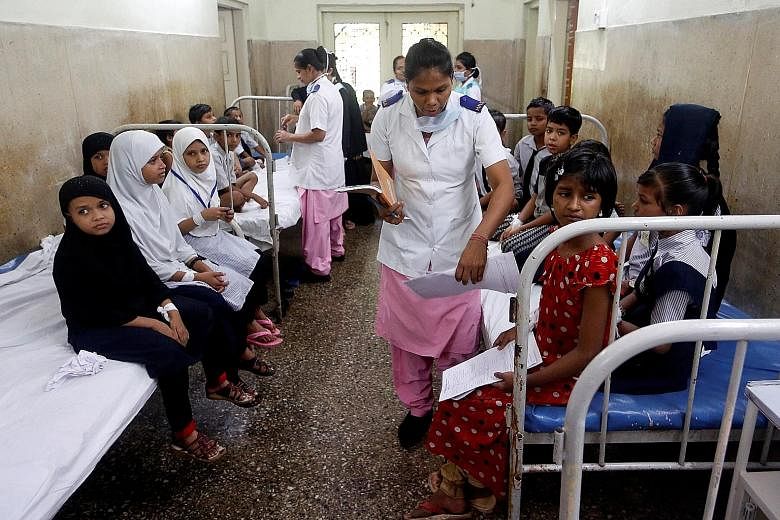As many as 55 million Indians were pushed into poverty in 2011-2012 because of out-of-pocket health expenses, a study released in May by the Public Health Foundation of India showed.
In a bid to help them, a government-funded health insurance scheme, the Pradhan Mantri Jan Arogya Yojana, was launched last week to cover over half a billion Indians.
The scheme offers health insurance of up to 500,000 rupees (S$9,500) covering all members of a household for one year.
Beneficiaries will primarily include India's most vulnerable - those below the poverty line and workers from the informal sector, some of whom already benefit from other state-sponsored health insurance programmes.
The new scheme covers hospitalisation-related expenses for more than 1,300 medical and surgical packages, including those related to cardiology, neurosurgery and oncology. The plan is part of the government's larger Ayushman Bharat ("Long Life India") healthcare policy that also includes opening 150,000 health and wellness centres by 2022.
It is a much-needed safety net in a country where government data shows its citizens pay for nearly 70 per cent of healthcare costs out of their own pockets.
However, the ambitious scheme, launched just eight months away from the next general elections and already dubbed "Modicare" after Prime Minister Narendra Modi, is being criticised for being underfunded and overlooking the pitfalls of India's grossly inadequate public health infrastructure.
The government has so far budgeted 20 billion rupees for the scheme for 2018-2019, but the Finance Ministry expects it to cost six times more.
Independent estimates put this figure much higher - at 500 billion rupees. The chief executive of Ayushman Bharat, Dr Indu Bhushan, told The Sunday Times he did not think the lack of finance was "a real possibility", saying: "This is a flagship initiative of the government and it is fully committed to financing the scheme."
Jointly run by the central and state governments, most states participating in this scheme have opted to set up either subsidy pools to pay public and private hospitals on their panel or sign contracts with insurance providers.
Five non-Bharatiya Janata Party (BJP) states have opted out of this scheme and will continue with their ongoing healthcare models. The BJP is the ruling party in India.
-
SPENDING ON HEALTH
(Percentage of GDP)
-
INDIA
1%
THAILAND
3%
BRAZIL
8%
The People's Health Movement-India, a lobby group, has criticised the scheme's reliance on a "discredited insurance model" that has plagued other government health schemes.
The scheme has also been criticised for leaving out expenses incurred for outpatient services, such as consultation fees for doctors and medicine costs, which form more than half of the out-of-pocket expenses incurred by patients.
Responding, Dr Bhushan said Ayushman Bharat "complements other (government) efforts already under way" that provide free medicines. "We could consider outpatient costs at a later stage once the scheme stabilises," he added.
The People's Health Movement-India also called for the new scheme to be scrapped and funds and focus to be diverted to strengthening public healthcare infrastructure in the country. India spends a little over 1 per cent of its gross domestic product on health, a figure that has remained almost unchanged since 2009. Countries such as Brazil and Thailand spend more than 8 and 3 per cent of their respective GDP on healthcare.
This has prompted repeated calls on the government to invest more in ramping up its rural medical facilities, including through training and regularised recruitment of medical workers, especially from rural areas.
Dr R. N. Tandon, the secretary general of the Indian Medical Association, also thinks the focus should be on improving both government primary healthcare facilities as well as private medical institutions, saying: "The scheme lays undue stress on tertiary care when what we need are good doctors who are accessible in rural areas and can diagnose and give preventive therapy to everyone. That is the best way to detect diseases early and treat them."
India's public healthcare infrastructure has been crippled by the lack of professionals.
Official data shows there is only 0.62 doctor for every 1,000 individuals, one government hospital bed for every 2,046 people, and one state-run hospital for every 90,343 people.
The low fixed treatment rates under this scheme have also prompted concerns of compromised medical care.
"The government has assured us they are looking at the costing methodology to revise the package prices because some of the costs proposed make it rather impossible to deliver quality care," Dr Tandon said.
While poor medical infrastructure might get in the way, Dr Bhushan felt that the scheme will improve the medical infrastructure in the long run by encouraging the use of both private and public healthcare services.
"It is indeed a long journey," he said. "We will take continuous feedback and keep evolving the scheme. If we succeed, you will see a totally different picture - a much better one, of course - of the health sector in India," he added.

